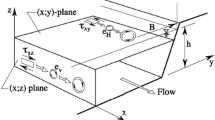Abstract
An accurate representation of permeability anisotropy is needed to model the rate and direction of groundwater flow correctly. We develop a wavelet analysis technique that can be used to characterize principal directions of anisotropy in both stationary and non-stationary permeability fields. Wavelet analysis involves the integral transform of a field using a wavelet as a kernel. The wavelet is shifted, scaled, and rotated to analyze different locations, sizes, and orientations of the field. The wavelet variance is used to identify scales and orientations that dominate the field. If the field is non-stationary, such that different zones of the field are characterized by different dominant scales or orientations, the wavelet variance can identify all dominant scales and orientations if they are distinct. If the dominant scales and orientations of different zones are similar, the wavelet variance identifies only the dominant scale and orientation of the primary zone. In this paper, we present a combined wavelet analysis and filtering approach to identify all dominant scales and orientations in a non-stationary permeability field. We apply the method to permeability data obtained in the laboratory from the Massillon sandstone.
Similar content being viewed by others
References
Anderman ER, Kipp KL, Hill MC, Valstar, Neupauer RM (2002) MODFLOW-2000, the U.S. geological survey modular ground-water model—documentation of the model-layer variable-direction horizontal anisotropy (LVDA) capability of the hydrogeologic-unit flow (HUF) package. U.S. Geological Survey, Open file Report 02-409
Antoine J, Murenzi R, Vandergheynst P, Ali ST (2004) Two-dimensional wavelet and their relatives. Cambridge University Press, Cambridge
Bear J (1972) Dynamics of fluids in porous media. American Elsevier, New York
Beckwith CW, Baird AJ, Heathwaite AL (2003) Anisotropy and depth-related heterogeneity of hydraulic conductivity in a bog peat. II: Modelling the effects on groundwater flow. Hydrol Process 17:103–113
Burton WC, Plummer LN, Busenberg E, Lindsey BD, Gburek WJ (2002) Influence of fracture anisotropy on groundwater ages and chemistry, Valley and Ridge Province, Pennsylvania. Ground Water 40(3):242–257
Candès EJ, Donoho DL (1999) Ridgelets: a key to higher-dimensional intermittency? Philos Trans R Soc Lond A 357:2495–2509
Chen XH, Chen X (2003) Effects of aquifer anisotropy on the migration of infiltrated stream water to a pumping well. J Hydrol Eng ASCE 8(5):287–293
Chui CK (1992) An introduction to wavelets. Academic Press, San Diego
Daubechies I (1992) Ten lectures on wavelets. Society of Industrial and Applied Mathematics, Philadelphia
Donoho DL, Flesia AG (2003) Digital ridgelet transform based on true ridge functions. In: Welland GV (ed.) Beyond wavelets. Academic Press, San Diego, pp 1–30
Farge M (1992) Wavelet transforms and their applications to turbulence. Annu Rev Fluid Mech 24:395–457
Genereux D, Bandopadhyay I (2001) Numerical investigation of lake bed seepage patterns: effects of porous medium and lake properties. J Hydrol 241(3–4):283–303
Isaaks EH, Srivastava RM (1989) An introduction to applied geostatistics. Oxford University Press, New York
Kumar P, Foufoula-Georgiou E (1997) Wavelet analysis for geophysical applications. Rev Geophys 35(4):385–412
Lark RM, Webster R (2004) Analysing soil variation in two dimensions with the discrete wavelet transform. Eur J Soil Sci 55:777–797
Neupauer RM, Powell KL, Qi X, Lee DH, Villhauer DA (2006) Characterization of permeability anisotropy using wavelet analysis. Water Resour Res 42:W07419. doi:10.1029/2005WR004364
Powell KL (2004) Wavelet analysis of permeability anisotropy. Master’s Thesis, University of Virginia, 89 pp
Tidwell VC, Wilson JL (2000) Heterogeneity, permeability patterns, and permeability upscaling: physical characterization of a block of Massillon Sandstone exhibiting nested scales of heterogeneity. SPE Reserv Eval Eng 3(4):283–291
Torrence C, Compo GP (1998) A practical guide to wavelet analysis. Bull Am Meteorol Soc 79(1):61–78
Author information
Authors and Affiliations
Corresponding author
Rights and permissions
About this article
Cite this article
Watkins, L., Neupauer, R.M. & Compo, G.P. Wavelet Analysis and Filtering to Identify Dominant Orientations of Permeability Anisotropy. Math Geosci 41, 643–659 (2009). https://doi.org/10.1007/s11004-009-9231-7
Received:
Accepted:
Published:
Issue Date:
DOI: https://doi.org/10.1007/s11004-009-9231-7




